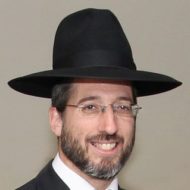
We live in a fantastic world, filled with colourful scenery, delicious food, awesome activities.
The Torah refers to earth as “Eretz”.
The Midrash (Bereshit Rabba 5) elaborates: “And G-d named the dry land ‘Earth.’”
Why was it named “earth” (“Eretz” in Hebrew)? Because it desired (“Ratzah” – similar to the Hebrew root in the word “Eretz”) to perform the will of the Creator.
The Midrash continues – “And what is the meaning of the name ‘Almighty’ (Shaddai)?” R. Nathan says in the name of R. Acha, and R. Brachya says in the name of R. Yitzchak: “[When God said:] ‘I am the Almighty God,’ [what He meant was:] ‘I am He Who told the heavens and earth ‘Enough!’ (“She-ddai”), for, had I not done so, they would have continued expanding endlessly until this very day.’”
Our Sages state that from here we see that it is possible to learn fear of Heaven by observing the nature of the earth – the earth which “desired to perform the Will of the Creator.”
Furthermore, the fact that the Almighty told the Heavens and Earth “Enough!” tells us that there was “enough” of what had been created in order to teach us about the existence of God.
Recently there has been much debate about God and science.
I want to share with you a fascinating part of an article by Eric Metaxas (Wall Street Journal, Dec 25th 2014).
“In 1966, Time magazine ran a cover story asking: ‘Is God Dead?’ Many have accepted the cultural narrative that He’s obsolete—that as science progresses, there is less need for a “God” to explain the universe. Yet it turns out that the rumours of God’s death were premature. More amazing is that the relatively recent case for His existence comes from a surprising place—science itself.
Here’s the story: The same year Time featured the now-famous headline, the astronomer Carl Sagan announced that there were two important criteria for a planet to support life: The right kind of star, and a planet the right distance from that star. Given the roughly octillion—1 followed by 27 zeros—planets in the universe, there should have been about septillion—1 followed by 24 zeros—planets capable of supporting life.
With such spectacular odds, the Search for Extra-terrestrial Intelligence – a large, expensive collection of private and publicly funded projects launched in the 1960s – was sure to uncover something soon. Scientists listened with a vast radio telescopic network for signals that resembled coded intelligence and were not merely random. But as years passed, the silence from the rest of the universe was deafening. Congress defunded SETI in 1993, but the search continues with private funds. As of 2014, researchers have discovered precisely bubkis—0 followed by nothing.
What happened? As our knowledge of the universe increased, it became clear that there were far more factors necessary for life than Sagan supposed. His two parameters grew to 10 and then 20 and then 50, and so the number of potentially life-supporting planets decreased accordingly. The number dropped to a few thousand planets and kept on plummeting.
Even SETI proponents acknowledged the problem. Peter Schenkel wrote in a 2006 piece for Skeptical Inquirer magazine: “In light of new findings and insights, it seems appropriate to put excessive euphoria to rest . . . . We should quietly admit that the early estimates . . . may no longer be tenable.”
As factors continued to be discovered, the number of possible planets hit zero, and kept going. In other words, the odds turned against any planet in the universe supporting life, including this one. Probability said that we shouldn’t even be here.
Today there are more than 200 known parameters necessary for a planet to support life—every single one of which must be perfectly met, or the whole thing falls apart. Without a massive planet like Jupiter nearby, whose gravity will draw away asteroids, a thousand times as many would hit Earth’s surface. The odds against life in the universe are simply astonishing.
Yet here we are, not only existing, but talking about existing. What can account for it? Can every one of those many parameters have been perfect by accident? At what point is it fair to admit that science suggests that we cannot be the result of random forces? Doesn’t assuming that an Intelligence created these perfect conditions require far less faith than believing that a life-sustaining Earth just happened to beat the inconceivable odds to come into being?
There’s more. The fine-tuning necessary for life to exist on a planet is nothing compared with the fine-tuning required for the universe to exist at all. For example, astrophysicists now know that the values of the four fundamental forces—gravity, the electromagnetic force, and the “strong” and “weak” nuclear forces—were determined less than one millionth of a second after the big bang. Alter any one value and the universe could not exist. For instance, if the ratio between the nuclear strong force and the electromagnetic force had been off by the tiniest fraction of the tiniest fraction—by even one part in 100,000,000,000,000,000—then no stars could have ever formed at all. Feel free to gulp…
Scientists and professors have debated this for decades, and we know from a Jewish perspective that Hashem requires us to have Emuna – “faith”, which by definition means there is no clear cut evidence that God exists. If there were, then there would be no free will to make decisions; rather God has placed amongst us some eye openers.
At the end of the day, it’s down to us to put everything together – our amazing world, together with our awesome heritage and tradition, and implant Emuna that G-d provides and takes care of the entire universe.
The Zohar (Terumah, 161b) writes that “the Almighty looked into the Torah and created the universe,” and if, indeed, the Torah is the scheme of the universe, then it must be possible to learn from the universe about the Torah, i.e. God.
In Egypt God showed that He was ruler of the world. Our ancestors witnessed the ten plagues hitting Egypt and by the end of this historical episode, they “knew”, as did Pharoah, that Hashem was the Ruler of the universe. GOd (through Mosheh) had to lead Pharaoh from “I don’t know Hashem” (Shemot 5:2) to a status of Pharaoh acknowledging God (12:32).
All of nature was and will always be under His Jurisdiction.
Every year we come back to this story in order to infuse in us that faith and understanding so that we can bring the Omnipresent God into our daily lives.
Let us internalise the wonderful world we live in, let us appreciate Hashem and may we come to a realisation that He was, is and always will be with us.







